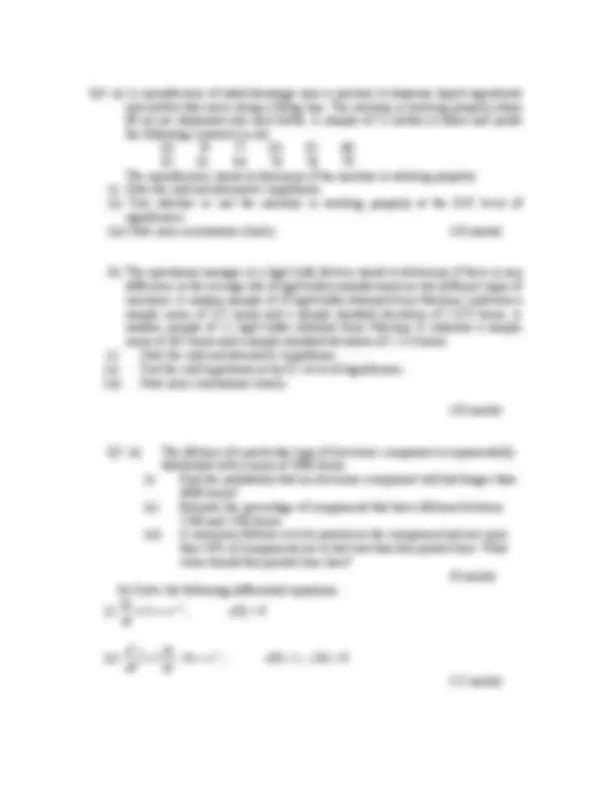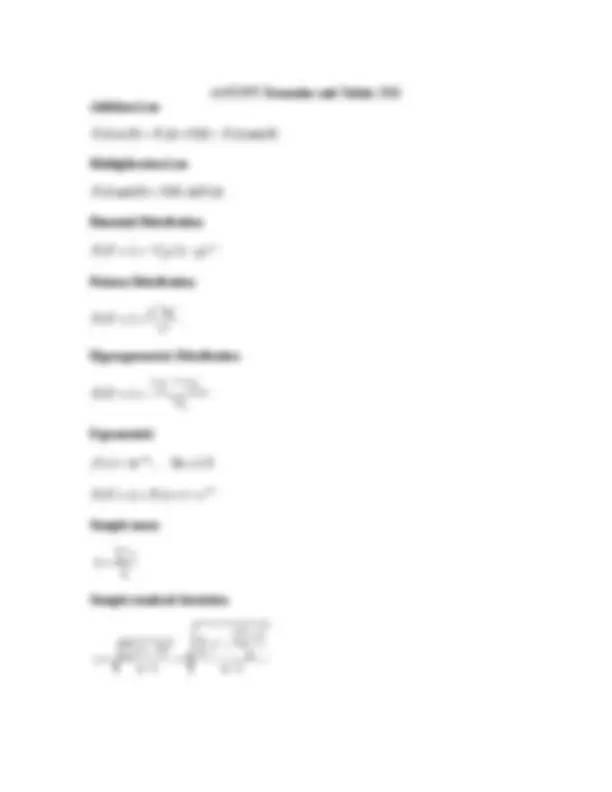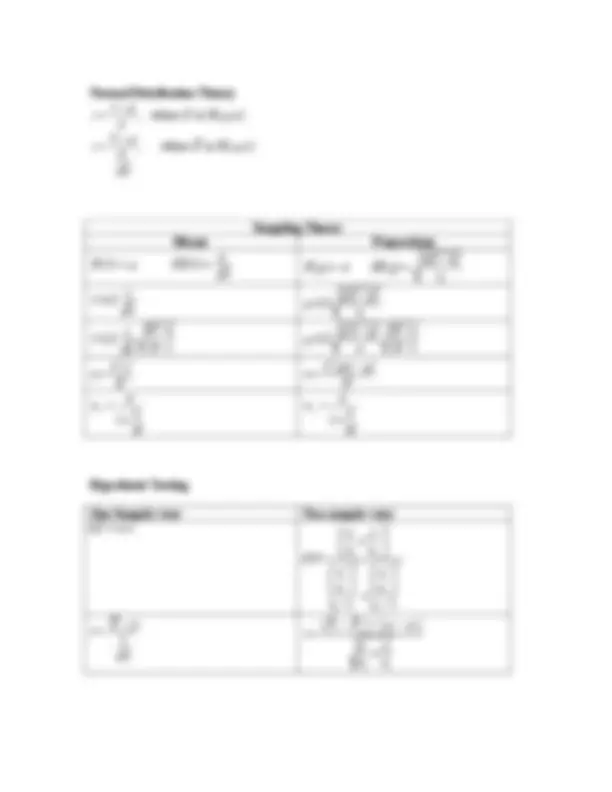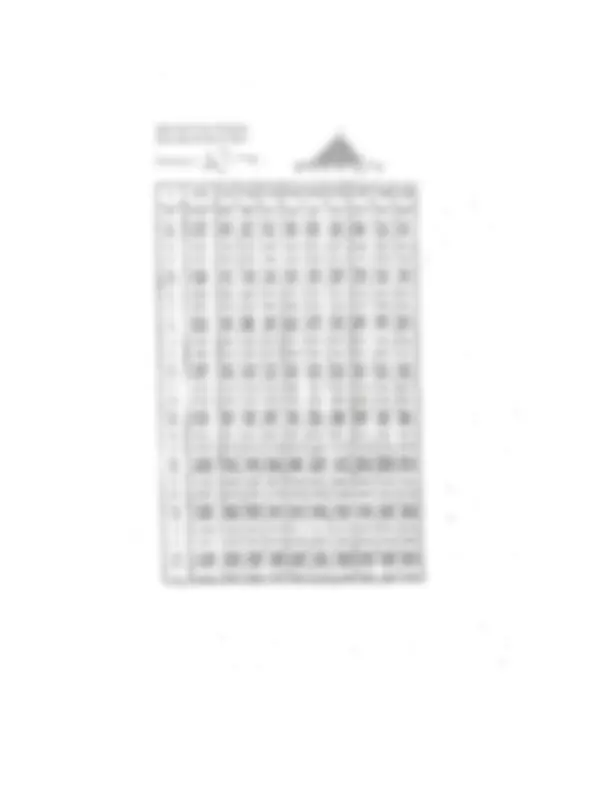






Study with the several resources on Docsity

Earn points by helping other students or get them with a premium plan


Prepare for your exams
Study with the several resources on Docsity

Earn points to download
Earn points by helping other students or get them with a premium plan
Community
Ask the community for help and clear up your study doubts
Discover the best universities in your country according to Docsity users
Free resources
Download our free guides on studying techniques, anxiety management strategies, and thesis advice from Docsity tutors
Exam questions for students in the bachelor of science (honours) in advanced manufacturing technology and process plant technology programs at cork institute of technology. The questions cover topics such as probability, statistical analysis, and hypothesis testing. Students are required to answer three questions within the given time frame and with the provided statistical tables.
Typology: Exams
1 / 8

This page cannot be seen from the preview
Don't miss anything!





Bachelor of Science (Honours) in Advanced Manufacturing Technology – Award
Autumn 2008
Bridging Mathematics
(Time: 1.5 Hours)
Instructions: Examiners: Dr. T. Creedon Answer three questions Mr. C. O’Conaill Statistical tables are provided Mr. N. Kingston Mr. J. Phelan
Q1. (a) Two methods, A and B, are available for teaching a certain industrial skill. The failure rate is 20% for A and 10% for B. However, B is more expensive and hence is used only 30% of the time, with A being used the other 70%.
(i) What percentage of workers fail to learn the skill properly?
(ii) A worker fails to learn the skill properly. What is the probability that he was taught by method A? (7 marks)
(b) Let A and B be events such that P(A) = 0.4, P(B) = 0.5 and P(A or B) = 0.7.
(i) Evaluate P(A and B);
(ii) Evaluate P(B|A);
(iii) Are A and B mutually exclusive events?
(iv) Are A and B independent events? (7 marks)
(c) The probability that an electronic timer is non-conforming is 0.03. A sample of size 50 is taken from a large batch of such items. Determine the probability of finding 2 or fewer non-conforming timers. (6 marks)
Q2.(a) The number of computer input errors per minute made by a particular computer programmer has a Poisson distribution with mean 0.75 errors per minute. (i) What is the probability that the programmer will make no errors in a minute? (ii) What is the probability that the programmer will make less than 2 errors in a 4-minute interval? (5 marks)
(b) Shipments of silicon wafers are to be inspected by an engineer in a microchip manufacturing plant. Each shipment consists of a batch of 1, silicon wafers. The engineer can only determine if the silicon wafers are acceptable by using a destructive test. The procedure is as follows: Select 6 wafers at random from the batch and test these. If all 6 pass the test, accept the batch. If 2 or more fail, reject the batch. If only 1 wafer fails, take a second sample of 6 waders. If all 6 wafers in the second sample pass the test, accept the batch; otherwise reject the batch. What is the probability of accepting a batch in which 5% of the silicon wafers are defective? (8 marks)
(c) A machine produces can tops whose diameters are normally distributed with a standard deviation of 0.01 cm. At what “nominal” mean diameter should the machine be set so that no more than 5% of the can tops have diameters exceeding 3 cm? (7 marks)
Q3. (a) A machine that automatically packs flour into bags is known to operate so that the contents of bags are normally distributed with mean 5 kg and standard deviation 0.02 kg. What is the probability that 10 such bags have a mean weight less than 4.99 kg? (5 marks)
(b) The repair times (in hours) for 16 electronic instruments are shown below.
159 280 101 212 224 379 179 264 222 362 168 250 149 260 285 170
Find a 99 % confidence interval for the mean repair time. (7 marks)
(c) A large shipment of electronic components is received. A sample of 50 electronic components is taken and reveals that 7 of these are defective. (i) Find a 95 % confidence interval for the proportion of electronic components in the shipment that are defective. (ii) What sample size would be necessary to estimate this population proportion to within 0.02 with 99 % confidence? (8 marks)
AMT/PPT Formulae and Tables 2008 Addition Law
P A ( or B ) = P A ( ) + P B ( ) − P A ( and B )
Multiplication Law
P A ( and B ) = P B ( | A P A ) ( )
Binomial Distribution
P X ( = r ) = n^ C pr r^ (1 − p ) n^ − r
Poisson Distribution
e m^ mr P X r r
− = =
Hypergeometric Distribution
M N M r n r N n
P X r C
− = = −
Exponential
P X ( ≤ x ) = F x ( ) = 1 − e −^ λ x
Sample mean
x x n
= ∑
Sample standard deviation
( )
2 2 2 ( ) 1 1
x x x x s n n n
∑ ∑ ∑
Normal Distribution Theory
, where is ( , )
x z X N
, where is ( , )
x z X N
n
Sampling Theory Means Proportions
E x ( ) SD x ( ) n
n
s x Z n
± (^) p Z p (1^^ p ) n
s N n x Z n N
p p N n p Z n N
2 2 2
Z s n E
2 2
Z p (1 p ) n E
f
n n n N
f
n n n N
Hypothesis Testing
One Sample t test Two sample t test d.f. = n- 1
d.f .=
2 2 2 1 2 1 2 2 2 2 2 1 2 1 2 1 1 2 1
s s n n s s n n n n
t s n
− μ = (^1 2 )^ (^1 2 ) 2 2 1 2 1 2
t s s n n